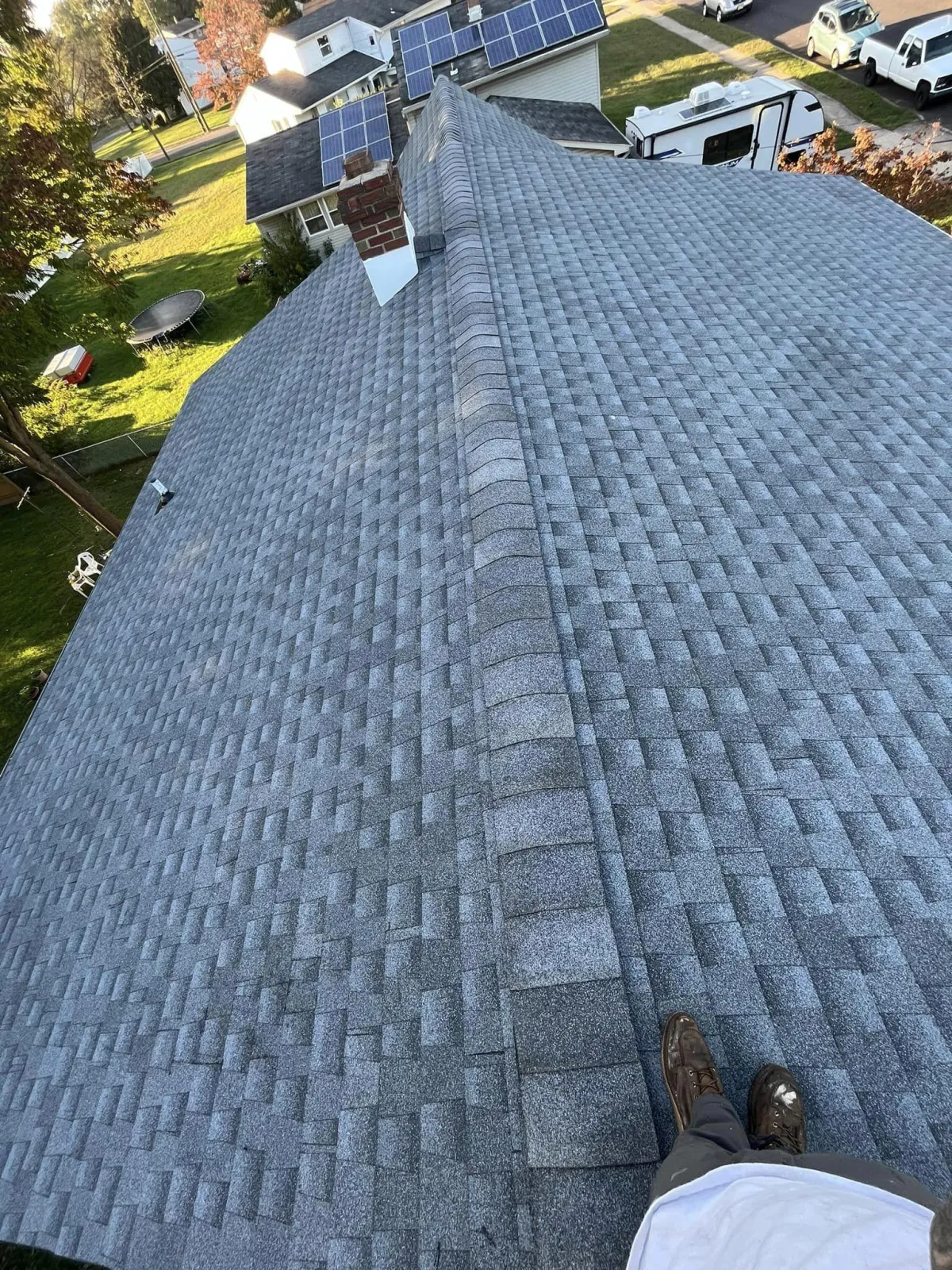Blogs

Residential vs Commercial Roofing: What are the Differences?
Residential roofing typically involves materials such as asphalt shingles, wood shakes, and metal panels, designed for homes with pitched roofs, focusing on aesthetic appeal and durability. In contrast, commercial roofing often uses materials like single-ply membranes (TPO, EPDM), built-up roofing (BUR), and modified bitumen, tailored for flat or low-slope roofs on larger buildings, prioritizing durability and energy efficiency. Commercial roofs usually require more maintenance and have more complex installation processes due to their size and structure.
At Northeast Exteriors, it's important to know the differences between residential and commercial roofs. Each type has different purposes and needs specific designs, materials, and maintenance. Let's explore these differences to help you choose the right roof for your needs.
Key Takeaways:
Roof Design: Residential roofs are typically steeply pitched and smaller in size, while commercial roofs are often flat or low-sloped, covering larger areas and accommodating various installations like HVAC systems and skylights.
Roofing Materials: Residential roofs commonly feature asphalt shingles, wood shakes, and tiles, whereas commercial roofs utilize materials such as modified bitumen, single-ply membranes (PVC, TPO, EPDM), and sprayed polyurethane foam.
Installation and Maintenance: Commercial roofs are more complex and time-consuming to install due to their size and additional layers, requiring more frequent inspections and maintenance compared to residential roofs.
Types of Residential Roofing
Choosing the right roofing material is crucial for the durability, appearance, and overall value of your home. Here are some of the most popular types of residential roofing:
Asphalt Shingles
Description: The most common roofing material due to their affordability and ease of installation.
Pros: Cost-effective, easy to install, available in various colors and styles.
Cons: Limited lifespan (15-30 years), susceptible to wind damage.
Wood Shakes and Shingles
Description: Offers a natural and rustic look, often made from cedar, redwood, or pine.
Pros: Aesthetic appeal, good insulation, eco-friendly.
Cons: Higher cost, requires more maintenance, vulnerable to fire unless treated.
Metal Roofing
Description: Includes materials like steel, aluminum, copper, and zinc, known for their durability.
Pros: Long-lasting (40-70 years), fire-resistant, energy-efficient, recyclable.
Cons: Higher upfront cost, can be noisy during rain or hail.
Tile Roofing
Description: Made from clay or concrete, providing a distinct and elegant look.
Pros: Extremely durable, long lifespan (50-100 years), fire-resistant.
Cons: Heavy, expensive, requires professional installation.
Slate Roofing
Description: Natural stone tiles known for their beauty and longevity.
Pros: Extremely durable, long lifespan (75-100 years), low maintenance.
Cons: Very heavy, very expensive, requires reinforced roof structure.
Synthetic Roofing
Description: Made from plastic, rubber, or polymer, mimicking natural materials like slate and wood.
Pros: Lightweight, affordable, low maintenance, and versatile in design.
Cons: Newer product with unknown long-term durability, can be less aesthetically pleasing than natural materials.
Selecting the right type of roofing for your home depends on various factors including your budget, aesthetic preferences, and the climate in your area.
Types of Commercial Roofing
Selecting the right roofing system for commercial properties is crucial for ensuring longevity, energy efficiency, and cost-effectiveness. Here are some of the most popular types of commercial roofing:
Built-Up Roofing (BUR)
Description: Composed of multiple layers of bitumen (asphalt or tar) and reinforcing fabrics.
Pros: Excellent waterproofing, UV protection, low maintenance.
Cons: Heavy, time-consuming installation, potential odor during installation.
Modified Bitumen Roofing
Description: Similar to BUR but with added polymers for increased elasticity and performance.
Pros: Durable, easy to maintain, excellent tensile strength.
Cons: Requires professional installation, moderate cost.
Single-Ply Membrane Roofing
Types: EPDM, TPO, PVC.
Pros: Lightweight, flexible, easy to install, and repair.
Cons: Vulnerable to punctures, varying performance based on material.
Spray Polyurethane Foam (SPF) Roofing
Description: Applied as a liquid that expands into a foam, creating a solid layer across the roof.
Pros: Seamless, excellent insulation properties, lightweight.
Cons: Requires professional installation, sensitive to weather during application.
Metal Roofing
Description: Often made from steel, aluminum, or copper, known for its longevity.
Pros: Durable low maintenance, energy-efficient, recyclable.
Cons: Higher upfront cost, potential for noise without proper insulation.
Green Roofing
Description: A sustainable option involving the installation of vegetation over a waterproof membrane.
Pros: Eco-friendly, reduces urban heat island effect, provides insulation.
Cons: High initial cost, requires regular maintenance.
Shingle Roofing
Description: Often used for small commercial buildings, similar to residential roofing.
Pros: Affordable, easy to install and repair.
Cons: Shorter lifespan, not suitable for large flat roofs.
Built-Up Roofing (BUR)
Description: Made from multiple layers of bitumen and fabric, finished with a top layer of gravel or stone.
Pros: Highly durable, good waterproofing, low maintenance.
Cons: Heavy, longer installation time, can have a strong odor.
Choosing the right commercial roofing system depends on factors such as the building's design, climate, budget, and specific needs.
Lifespan of Residential vs. Commercial Roofing
Understanding the lifespan of different roofing types is crucial for planning maintenance, budgeting, and ensuring the longevity of your property. Here’s a breakdown of the typical lifespans for residential and commercial roofing materials:
Residential Roofing
Asphalt Shingles
Lifespan: 15-30 years
Details: The most common residential roofing material, asphalt shingles offer an economical and versatile solution, though their lifespan can be affected by weather conditions and installation quality.
Wood Shakes and Shingles
Lifespan: 20-40 years
Details: These provide a natural, rustic appearance and can last longer with proper maintenance, but they are vulnerable to fire, rot, and insect damage.
Metal Roofing
Lifespan: 40-70 years
Details: Known for its durability, metal roofing is resistant to extreme weather and fire, making it a long-lasting choice for residential homes.
Tile Roofing
Lifespan: 50-100 years
Details: Made from clay or concrete, tile roofing is exceptionally durable and aesthetically pleasing, but it requires a strong underlying structure due to its weight.
Slate Roofing
Lifespan: 75-100 years
Details: Slate offers unparalleled longevity and a classic look, though it is one of the most expensive roofing materials and requires professional installation.
Synthetic Roofing
Lifespan: 20-50 years
Details: Composed of materials like plastic, rubber, or polymer, synthetic roofing mimics natural materials and offers durability with lower maintenance requirements.
Commercial Roofing
Built-Up Roofing (BUR)
Lifespan: 20-30 years
Details: BUR systems, composed of multiple layers of bitumen and reinforcing fabrics, provide excellent waterproofing and durability for flat roofs.
Modified Bitumen
Lifespan: 20-25 years
Details: Similar to BUR but with added polymers for increased flexibility, modified bitumen roofing offers a durable and resilient solution for commercial buildings.
Single-Ply Membrane Roofing (EPDM, TPO, PVC)
Lifespan: 20-30 years
Details: These materials are lightweight and easy to install, providing effective weather resistance and flexibility for various commercial applications.
Spray Polyurethane Foam (SPF) Roofing
Lifespan: 20-25 years
Details: SPF roofing provides excellent insulation and seamless coverage, though it requires professional installation and regular maintenance to maximize its lifespan.
Metal Roofing
Lifespan: 40-70 years
Details: Commercial metal roofs are valued for their longevity, energy efficiency, and low maintenance, making them a cost-effective choice over time.
Green Roofing
Lifespan: 30-50 years
Details: Green roofs, incorporating vegetation over a waterproof membrane, offer environmental benefits and long-term durability with proper care and maintenance.
Environmental Impact: Residential vs. Commercial Roofing
The environmental impact of roofing materials and systems is a crucial consideration in today’s construction practices. Both residential and commercial roofing have distinct effects on the environment, from material production to energy efficiency and disposal. Here’s a look at the environmental impact of various roofing options:
Residential Roofing
Asphalt Shingles
Environmental Impact: High energy consumption and greenhouse gas emissions during production; limited recyclability.
Mitigation: Choosing energy-efficient, reflective shingles can reduce home cooling costs and energy use.
Wood Shakes and Shingles
Environmental Impact: Sustainable if sourced from renewable forests; potential issues with pesticide treatments.
Mitigation: Using untreated or naturally treated wood from certified sustainable sources can minimize environmental harm.
Metal Roofing
Environmental Impact: High energy use in manufacturing but recyclable and long-lasting.
Mitigation: Metal roofs reduce landfill waste due to their recyclability and long lifespan, and they can reflect solar heat, lowering energy costs.
Tile Roofing
Environmental Impact: Energy-intensive production process; heavy materials increase transportation emissions.
Mitigation: Tiles are durable and can last a century, reducing the need for frequent replacements.
Slate Roofing
Environmental Impact: Natural material with a low carbon footprint but heavy and difficult to transport.
Mitigation: Extremely durable, resulting in minimal replacements and waste over the building's lifespan.
Synthetic Roofing
Environmental Impact: Made from plastic or rubber, which may not be biodegradable; however, they can mimic natural materials and be more sustainable.
Mitigation: Opting for recycled synthetic materials can lower environmental impact.
Commercial Roofing
Built-Up Roofing (BUR)
Environmental Impact: Uses bitumen, a petroleum product; production emits pollutants.
Mitigation: Insulating properties of BUR can improve building energy efficiency, reducing heating and cooling demands.
Modified Bitumen
Environmental Impact: Similar to BUR, with high-energy production processes and petroleum-based materials.
Mitigation: Reflective coatings can reduce urban heat island effect and lower building energy consumption.
Single-Ply Membrane Roofing (EPDM, TPO, PVC)
Environmental Impact: Energy-intensive manufacturing; some types can release harmful chemicals.
Mitigation: Membranes are durable and can improve energy efficiency, especially when combined with insulation.
Spray Polyurethane Foam (SPF) Roofing
Environmental Impact: Requires chemicals for production and installation but offers excellent insulation.
Mitigation: High insulation values reduce energy use for heating and cooling, lowering overall carbon footprint.
Metal Roofing
Environmental Impact: Recyclable and long-lasting, but production is energy-intensive.
Mitigation: Reflective properties lower energy use, and recyclability reduces landfill waste.
Green Roofing
Environmental Impact: Positively impacts the environment by reducing urban heat island effect, improving air quality, and providing insulation.
Mitigation: Promotes biodiversity and stormwater management, and reduces energy costs.
FAQs
What are the typical materials used in residential roofing? Residential roofs often feature materials like asphalt shingles, wood shakes, metal panels, and tile, chosen for their durability and aesthetic appeal.
How does the cost of residential roofing compare to commercial roofing? Residential roofing costs can vary widely based on materials and roof size, typically lower per square foot compared to commercial roofs due to complexity and size.
What are the maintenance requirements for commercial roofing? Commercial roofs require regular inspections every six months to ensure the integrity of multiple layers and specialized materials, minimizing the risk of leaks and damage.
Can commercial roofing materials be used for residential projects? While some materials like metal panels may overlap, commercial roofing materials are generally designed for larger structures and may not be practical or cost-effective for typical residential applications.
How can I choose the right roofing contractor for my project? Look for contractors with expertise in both residential and commercial roofing, ensuring they
Choosing the Right Roofing Solution for Your Property - Northeast Exteriors
Selecting the ideal roofing solution involves weighing factors like design, materials, installation complexity, and maintenance requirements. Whether it's enhancing the charm of your home with residential roofing or ensuring the durability and functionality of your commercial property, Northeast Exteriors stands ready to deliver customized solutions tailored to your needs.
Contact us now for a consultation and discover how we can transform your roofing vision into reality with our transparent buying experience, custom solutions, and commitment to customer satisfaction.
Hours
Monday: 8:00AM - 6:00PM
Tuesday: 8:00AM - 6:00PM
Wednesday: 8:00AM - 6:00PM
Thursday: 8:00AM - 6:00PM
Friday: 8:00AM - 6:00PM
Copyright © Northeast Exteriors 2023. All Rights Reserved. Privacy Policy. Terms & Conditions. Web Design by Fused Media





